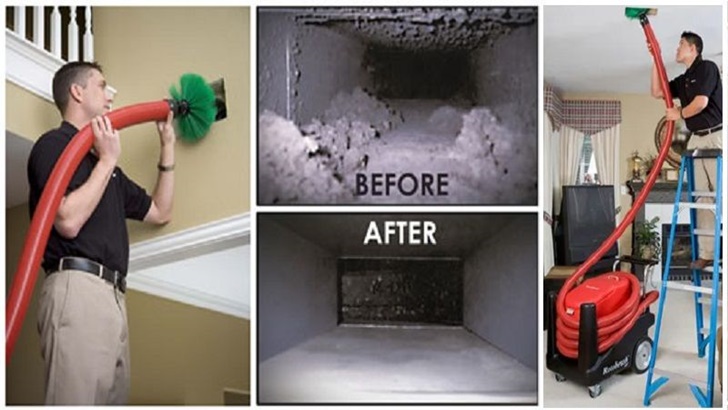Air duct cleaning is an essential maintenance procedure that ensures the efficiency of your heating, ventilation, and air conditioning (HVAC) system while also promoting a healthier indoor environment. In this article, we will delve into the intricate process of air duct cleaning, the methods used, and the benefits that come with it.

Understanding Air Ducts and Their Importance
Air ducts are conduits that carry heated or cooled air throughout a building. They play a pivotal role in maintaining indoor air quality and comfort. Over time, dust, allergens, and other contaminants can accumulate within these ducts, affecting both the efficiency of your HVAC system and the quality of air you breathe.
The Need for Air Duct Cleaning
As the air circulates through your home, it passes through the ducts, bringing with it dust, pollen, pet dander, mold spores, and other particulates. These can lead to health issues, particularly for individuals with allergies or respiratory conditions. Thus, routine air duct cleaning is crucial for:
Improving Air Quality: Reducing allergens and pollutants in the air.
Enhancing Energy Efficiency: Allowing your HVAC system to operate more efficiently.
Extending HVAC Lifespan: Minimizing strain on the system can lead to fewer repairs and a longer life.
The Air Duct Cleaning Process
Air duct cleaning involves several steps that ensure thorough cleaning and maintenance of your ducts. Let’s break down the process:
1. Initial Inspection
Before any cleaning takes place, a thorough inspection is conducted. This involves:
Visual Assessment: Technicians examine accessible ducts to identify blockages or contamination.
Assessment of Air Quality: Tools such as air quality monitors may be used to gauge the levels of pollutants present.
2. Preparation and Setup
Once the inspection is complete, technicians prepare the work area. This includes:
Protective Gear: Ensuring all personnel are equipped with masks and gloves to avoid inhaling dust and contaminants.
Setting Up Equipment: Deploying a vacuum system and other specialized tools necessary for cleaning.
3. Cleaning the Ducts
The actual cleaning process can vary, but it typically involves the following techniques:
– Negative Pressure Method
This is one of the most effective methods used in air duct cleaning. It involves:
Creating a Vacuum: A powerful vacuum is connected to the duct system to create negative pressure.
Dislodging Debris: Brushes and other tools are used to dislodge dirt and debris from the duct walls, which is then sucked into the vacuum system.
– Rotating Brush Method
This method employs mechanical brushes to scrub the insides of ducts:
Brush Deployment: Technicians insert rotating brushes into the ducts.
Debris Removal: The brushes loosen dirt and dust, which is subsequently collected by a vacuum.
4. Cleaning Other HVAC Components
In addition to air ducts, other components of the HVAC system may also require cleaning. This includes:
Blower Fans: These should be cleaned to ensure proper airflow and efficiency.
Coils: Cleaning evaporator and condenser coils helps improve the system’s efficiency.
5. Post-Cleaning Inspection
After the cleaning process is complete, a follow-up inspection is conducted to:
Verify Cleanliness: Ensure that all contaminants have been removed.
Check for Damage: Inspect the ducts for any damage or areas needing repair.
Benefits of Air Duct Cleaning
Investing in professional air duct cleaning offers numerous advantages that extend beyond simple cleanliness.
1. Enhanced Indoor Air Quality
By removing pollutants and allergens, air duct cleaning leads to improved indoor air quality, which is particularly beneficial for:
Allergy Sufferers: Reducing triggers that can lead to allergic reactions.
Individuals with Respiratory Issues: Providing a healthier living environment.
2. Increased Energy Efficiency
When ducts are clean, air can flow freely through the system. This efficiency leads to:
Lower Energy Bills: Reduced workload on HVAC systems can result in noticeable savings on energy costs.
Sustained System Performance: A well-maintained system operates more efficiently, leading to better temperature control.
3. Prolonged HVAC System Lifespan
Regular cleaning and maintenance can help extend the life of your HVAC system by:
Minimizing Wear and Tear: Less strain on the system results in fewer breakdowns.
Reducing Repair Costs: A clean system is less likely to experience significant failures, saving you money in the long run.
4. Odor Removal
Air ducts can trap odors from pets, cooking, and other household activities. Cleaning can help eliminate these smells, leading to a fresher home environment.
Conclusion
In conclusion, understanding how air duct cleaning works can empower homeowners to make informed decisions about their HVAC maintenance. Regular cleaning not only enhances indoor air quality but also contributes to energy efficiency and the longevity of your HVAC system. By investing in professional air duct cleaning, you ensure a healthier, more comfortable living space.
